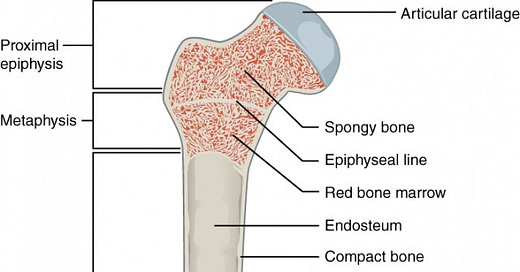Hello There Rheumatology Fans,
I am currently writing CPD content all about bone health so look out for that… In the meantime, here is a taster to get you excited!
What To Expect In This Article
Introduction
What Is Bone Mass
Factors Influencing Bone Mass
Bone Mass Across The Lifespan
Maintaining And Improving Bone Mass
Bone Mass Testing
Introduction
Bone mass is a vital marker of overall health but is asymptomatic until a problem arises. All Healthcare Professionals need to understand the risk factors for Low Bone Mass and if not provide advice at least sign post appropriately.
What is Bone Mass?
Bone mass refers to the density and strength of bones, measured by the amount of mineral content, primarily calcium and phosphorus, present in a specific volume of bone. Higher levels of bone mass assume a stronger bone that is less prone to fracture, this generally holds true unless certain circumstances dictate an uneven amount of bone mass. A good example of this is Ankylosing Spondylitis - Spinal ligaments ossify (more bone mass) but are prone to fracture do to poor quality.
Factors Influencing Bone Mass
Several factors influence bone mass:
Genetics: Genetic inheritance towards higher or lower bone mass. People with severely low bone mass or early onset osteoporosis often have a family history
Nutrition: A varied and high quality diet consisting of sufficient calories, calcium, vitamin d and protein throughout life is important. This can be influenced by tolerance, allergy or absorption differences
Physical Activity: Regular weight-bearing and resistance exercises stimulate bone formation and increase bone density especially in childhood but persisting throughout life
Hormonal Influences: Hormones such as estrogen and testosterone are vital for bone growth and maintenance. Imbalances or changes, particularly during menopause, can significantly impact bone mass.
Bone Mass Across the Lifespan
Bone mass changes throughout a person’s life, influenced by various growth and aging processes:
Childhood and Adolescence: During these years, bones grow rapidly in both size and density. Adequate nutrition and physical activity during this period are essential for developing strong bones.
Peak Bone Mass in Early Adulthood: Peak bone mass is usually reached by the late 20s. The higher the peak bone mass, the more bone reserve there is for later in life.
Bone Mass Decline with Aging: After reaching peak bone mass, bone density remains stable for a while but gradually begins to decline, particularly after the age of 50. This decline is more pronounced in women due to hormonal changes during menopause.
Maintaining and Improving Bone Mass
Proactive measures can help maintain and even improve bone mass:
Diet and Essential Nutrients: Ensure diet includes ample calcium-rich foods such as dairy products, leafy greens, and fortified foods. Vitamin D is equally important and can be obtained from sunlight, fatty fish. Calcium and Vitamin D are commonly supplemented as bioavailability from food can difficult to overcome
Exercise and Physical Activity: Engaging in regular physical activity that includes both weight-bearing exercises like walking and resistance exercises like weightlifting. These activities stimulate bone formation and enhance bone strength. There is increasing evidence for their safety even in those with low bone mass
Lifestyle Changes: Smoking and excessive alcohol consumption can negatively affect bone health. Quitting smoking and moderating alcohol intake can help maintain healthy bones.
Bone Mass Testing
The most common test is the DEXA scan, which measures bone density most commonly in the spine and hip. Females older than 65 and Males older than 70 should at a minimum be screened but likely it is better to have a DEXA scan. Younger people at risk (family history or other pre-disposing factors) should be screened irrelevant of age.
A Z-score is obtained from the DEXA scan, this compares the persons bone mass to the average of someone who is the same age, sex and size as the individual who is being tested. An alternative score is the T-score which compares to a healthy 30 year old of the same sex.







Thank you Jack I really appreciate the informative work you do, so helpful and important for clinical practice 👍